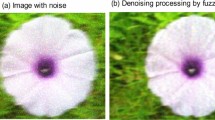Abstract
In order to overcome the discontinuity of geographic elements during the digitization of scanned topographic maps, a color map segmentation algorithm, which is used to segment color maps into different layers based on linear element features, is proposed in this paper. Linear elements are regarded as the elementary units in this method. We use background removal, thinning, nodes disconnection, labeling and dilation to get the elementary units. Then the main color, which could accurately represent the color feature of linear element, is extracted for clustering on the basis of Fuzzy c-means algorithm. At last, disconnected nodes are merged into the corresponding layers to keep the continuity of the results. The experimental results show that the proposed algorithm outperforms other segmentation approaches that regarding pixels as the elementary units.














Similar content being viewed by others
References
Ahmed MN, Yamany SM, Mohamed N, Farag AA, Moriarty T (2002) A modified fuzzy c-means algorithm for bias field estimation and segmentation of MRI data. IEEE Trans Med Imaging 21(3):193–199
Biosca JM, Lerma JL (2008) Unsupervised robust planar segmentation of terrestrial laser scanner point clouds based on fuzzy clustering methods. ISPRS J Photogramm Remote Sens 63(1):84–98
Cai W, Chen S, Zhang D (2007) Fast and robust fuzzy c-means clustering algorithms incorporating local information for image segmentation. Pattern Recogn 40(3):825–838
Campadelli P, Medici D, Schettini R (1997) Color image segmentation using Hopfield networks. Image Vis Comput 15(3):161–166
Celenk M (1990) A color clustering technique for image segmentation. Comput Vision, Graphics, Image Process 52(2):145–170
Chen H, Tang XA, Wang CH, Gan Z (2010) Object oriented segmentation of scanned topographical maps. J Image Graph 9:020
Chen Y, Wang R, Qian J (2006) Extracting contour lines from common-conditioned topographic maps. IEEE Trans Geosci Remote Sens 44(4):1048–1057
Gonzalez RC, Woods RE (2007) Digital image processing. Publishing House of Electronics Industry, Beijing, pp 423–439
Hathaway RJ, Bezdek JC (2001) Fuzzy c-means clustering of incomplete data. IEEE Trans Syst Man Cybern B: Cybern 31(5):735–744
Heipke C, Mayer H, Wiedemann C, Jamet O (1997) Evaluation of automatic road extraction. Int Arch Photogramm Remote Sens 32:151–160
Huang CL (1992) Parallel image segmentation using modified Hopfield model. Pattern Recogn Lett 13(5):345–353
Khotanzad A, Zink E (2003) Contour line and geographic feature extraction from USGS color topographical paper maps. IEEE Trans Pattern Anal Mach Intell 25(1):18–31
Kuntimad G, Ranganath HS (1999) Perfect image segmentation using pulse coupled neural networks. IEEE Trans Neural Netw 10(3):591–598
Kurugollu F, Sankur B, Harmanci AE (2001) Color image segmentation using histogram multithresholding and fusion. Image Vis Comput 19(13):915–928
Leyk, S (2010) Segmentation of colour layers in historical maps based on hierarchical colour sampling. In Graphics Recognition. Achievements, Challenges, and Evolution. Springer Berlin Heidelberg, pp 231–241
Leyk S, Boesch R (2010) Colors of the past: color image segmentation in historical topographic maps based on homogeneity. GeoInformatica 14(1):1–21
Lim WQ (2010) The discrete shearlet transform: a new directional transform and compactly supported shearlet frames. IEEE Trans Image Process 19(5):1166–1180
Lim YW, Lee SU (1990) On the color image segmentation algorithm based on the thresholding and the fuzzy c-means techniques. Pattern Recogn 23(9):935–952
Miao Q, Xu P, Liu T, Yang Y, Zhang J, Li W (2013) Linear feature separation from topographic maps using energy density and the shear transform. IEEE Trans Image Process 22(4):1548–1558
Ohlander R, Price K, Reddy DR (1978) Picture segmentation using a recursive region splitting method. Comput Graph Image Process 8(3):313–333
Ong SH, Yeo NC, Lee KH, Venkatesh YV, Cao DM (2002) Segmentation of color images using a two-stage self-organizing network.Image and. Vision Comput 20(4):279–289
Otsu N (1975) A threshold selection method from gray-level histograms. Automatica 11(285–296):23–27
Stewart RD, Fermin I, Opper M (2002) Region growing with pulse-coupled neural networks: an alternative to seeded region growing. IEEE Trans Neural Netw 13(6):1557–1562
Sun JG, Liu J, Zhao LY (2008) Clustering algorithms research. J Software 19(1):48–61
Tombre K (1995) Graphics recognition—general context and challenges. Pattern Recogn Lett 16(9):883–891
Wei S, Hong Q, Hou M (2011) Automatic image segmentation based on PCNN with adaptive threshold time constant. Neurocomputing 74(9):1485–1491
Wiedemann C, Heipke C, Mayer H, Jamet O (1998) Empirical evaluation of automatically extracted road axes. Empirical Evaluation Techniques in Computer Vision 172–187
Xin D, Zhou X, Zheng H (2006) Contour line extraction from paper-based topographic maps. J Inf Comput Sci 1(5):275–283
Xu R, Wunsch D (2005) Survey of clustering algorithms. IEEE Trans Neural Netw 16(3):645–678
Zheng H, Zhou X, Wang J (2003) Research and implementation of automatic color segmentation algorithm for scanned color maps. J Comput Aided Des Comput Graph 1:003
Zhuang H, Low KS, Yau WY (2012) Multichannel pulse-coupled-neural-network-based color image segmentation for object detection. IEEE Trans Ind Electron 59(8):3299–3308
Acknowledgments
The work was jointly supported by the National Natural Science Foundations of China under grant No. 61272280, 41271447, 61272195 and 61472302, the Program for New Century Excellent Talents in University (NCET-12-0919), the Fundamental Research Funds for the Central Universities under grant No. K5051203020, K5051303016, K5051303018, BDY081422, and K50513100006, the Creative Project of the Science and Technology State of xi’an under grant No. CXY1341(6), The State Key Laboratory of Geo-information Engineering under grant No. SKLGIE2014-M-4-4.
Author information
Authors and Affiliations
Corresponding author
Rights and permissions
About this article
Cite this article
Liu, T., Miao, Q., Xu, P. et al. Color topographical map segmentation Algorithm based on linear element features. Multimed Tools Appl 75, 5417–5438 (2016). https://doi.org/10.1007/s11042-015-2510-z
Received:
Revised:
Accepted:
Published:
Issue Date:
DOI: https://doi.org/10.1007/s11042-015-2510-z




